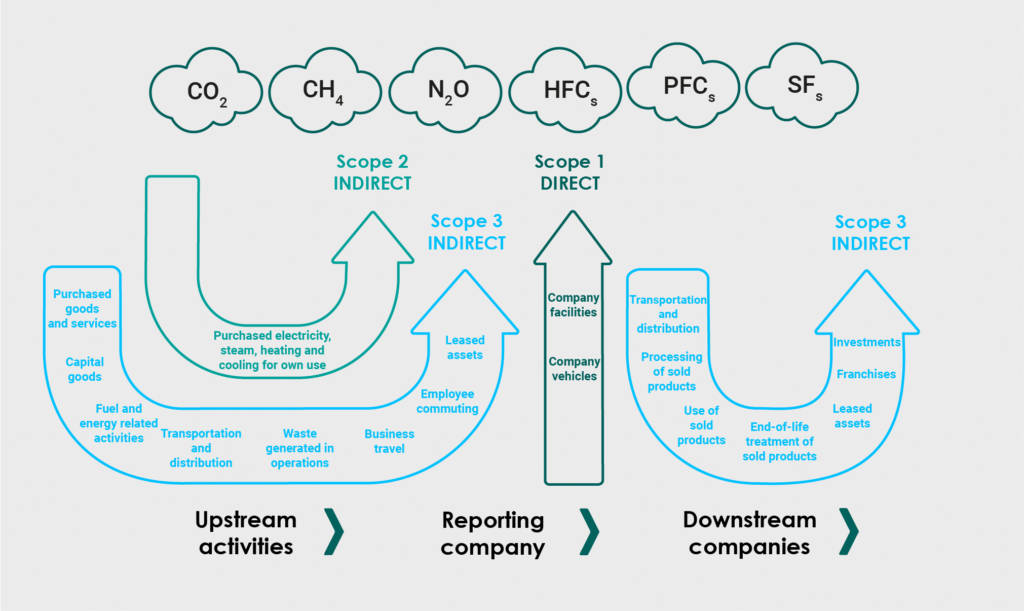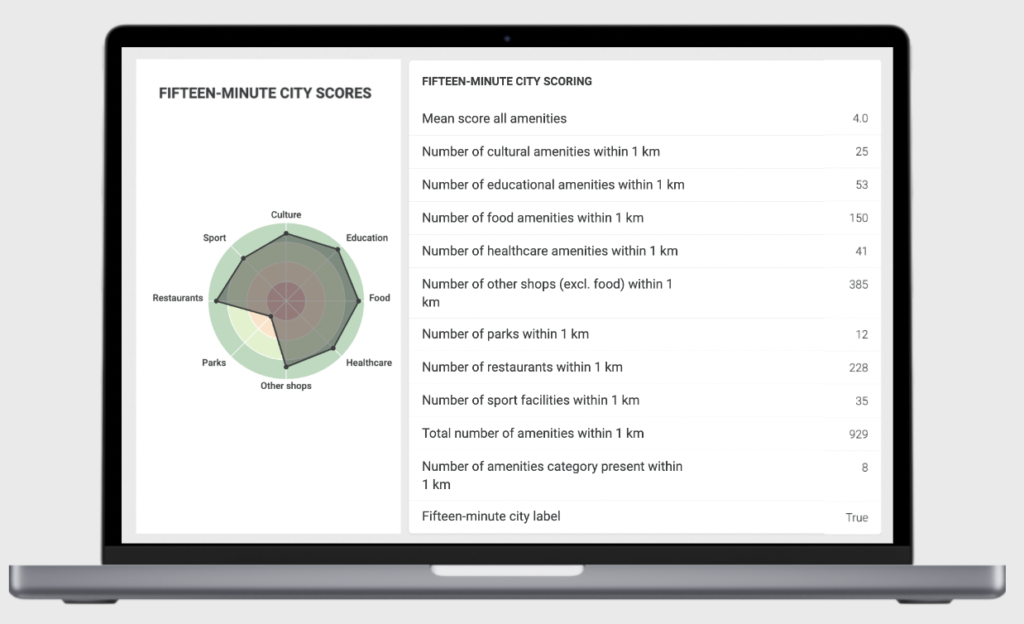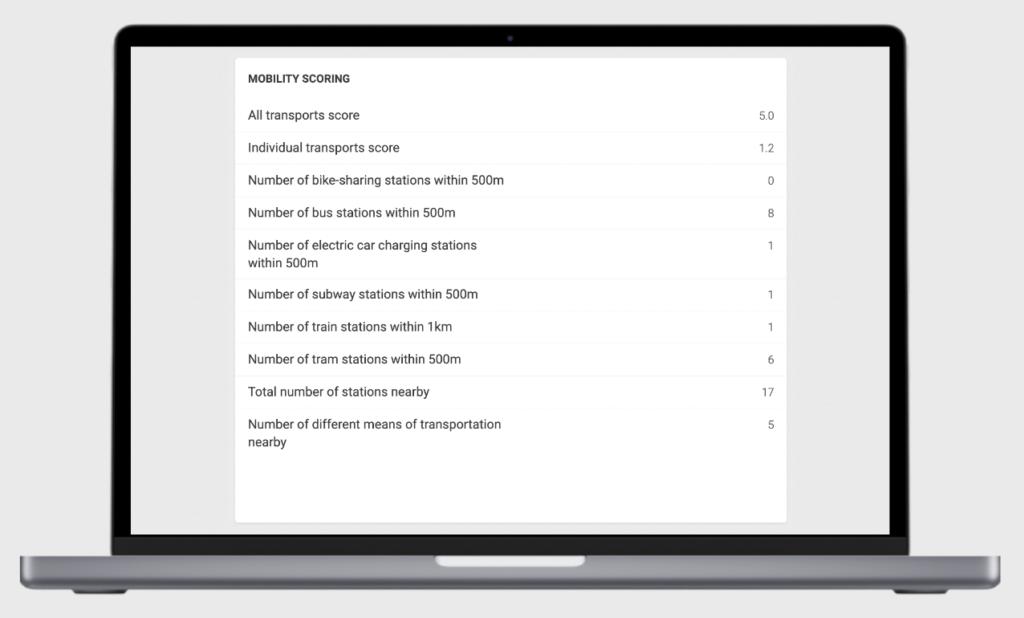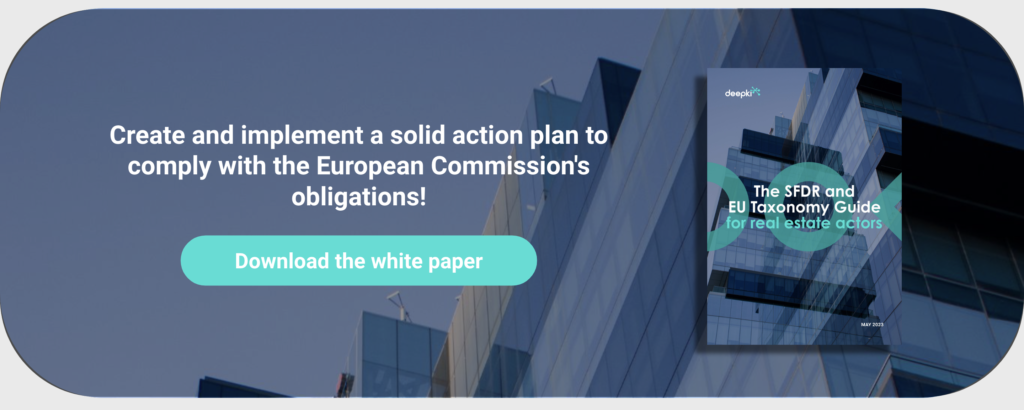While Environmental, Social, and Governance (ESG) issues increasingly dominate the real estate players’ agenda, these three elements do not receive equal attention. In this blog, Deepki delves into two new tools released this month on its ESG SaaS platform that concern both the E and the S. While the environmental considerations, particularly climate change, have been the primary focus, Deepki also focuses on the pillar that is often overlooked but has been put into sharp focus in recent years and in particular by the pandemic: the S in ESG.
Read more on ESG criteria
The need for a new urban paradigm
Recent reports by the Intergovernmental Panel on Climate Change (IPCC) and the United Nations Framework Convention on Climate Change (UNFCCC) warn that the global temperature peak will be beyond the Paris Agreement target of 2°C (preferably 1.5°C). It will reach a high of 2.7 °C pre-industrial levels by the end of this century (IPCC, 2021), as countries are far below their emissions targets. The anticipated temperature rise would be expected to affect and reduce the quality of life in urban communities. This is a critical point as more than 55% of the world’s population already lives in urban areas. Moreover, it is expected that by 2050, the global urban population will reach more than 68% (United Nations Human Settlements Programme).
In addition, urban areas are considered the main driver of various economies (contributing to over 70% of global GDP) around the world. Any disruptive factor related to them would have a cascading effect on nearly every major sector of the world’s economies. It is also noteworthy to understand that they are responsible for the emission of approximately more than 60% of global greenhouse gases (GHG). As a result, metropolitan areas have become major sources of pollution, affecting different parts of the environment.
The benefits of tracking Scope 3 for investors
Thus reducing carbon emissions has become a primary goal included in environmental strategies for all businesses and organizations. Born from the partnership of the World Resources Institute (WRI) and the World Business Council for Sustainable Development (WBCSD), the GHG Protocol classifies emissions according to three distinct categories or ‘scopes’:
- Scope 1 refers to direct GHG emissions from sources owned or controlled by the entity: boilers, furnaces, vehicles, etc. Refrigerants
- Scope 2 includes GHG emissions from the production of electricity, steam, heat, and cooling purchased or acquired and consumed by the entity
- Scope 3, also called ‘value chain emissions,’ includes all other indirect emissions that occur in an entity’s value chain as a result of its activities. There are 15 emission factors, including purchased goods and services, business travel, waste disposal, use of sold products, transportation and distribution, and investments, and what interests us in this blog: employee commuting. In Scope 3, the category Transport / Mobility includes all missions related to the transport of occupants of an asset which leads us to also look at the location of an asset to assess its global impact.

Read more on Scope 3: How these hard-to-tackle emissions could be a game changer
Because of the many stakeholders involved, Scope 3 emissions are more complex than those of Scope 1 and Scope 2, and more difficult to measure and reduce. City actors, therefore, have a key role to play in participating in and driving strong decarbonization efforts.
Assess the quality of your assets’ surroundings
In light of this, Deepki Ready™ has been developing and now offers two new scoring methods to help investors and Asset Managers take into account new dimensions of their real estate portfolio: Mobility Scoring and Fifteen-minute city scoring tools. These two features are already available in Deepki Ready™ and will help you correctly assess the amenities and transportation modes around your assets.
What you have to know about the Fifteen-minute city score
Living in a city means handling and supporting a certain level of dysfunction, such as long commutes, noisy streets, and underutilized spaces. Carlos Moreno, an urbanist and professor at the Sorbonne University in Paris, wanted to improve that. He advocated a ‘15-minute city,’ where residents could access all the services they needed to live, learn and thrive within their immediate proximity – explored how urban areas can adapt to people and not vice versa.
Thus Fifteen-minute city can be simply described as an ideal model of a city where all essential services are within a 15-minute walk or bike ride.
The model is divided into 5 main social functions:
- Work,
- Getting supplies,
- Learning,
- Health care,
- Entertainment.
The overall objective is to provide essential amenities, different housing types, and more green spaces available within a 15-minute walking or cycling distance. There are already 16 cities worldwide implementing a 15-minute city-style strategy or similar ideas or are working on doing so. Some cities, such as Paris and New York, are relatively more mature in this regard. They introduced participatory budgeting to promote local engagement as a part of their city transformation strategy. Cities such as Bogota, Seattle, and Milan are prioritizing investments in infrastructure for walking and cycling, with a focus on new urbanism and flexible concepts. Despite the name 15-minute city, the focus is not on zealously keeping this limit but rather allowing all residents to live locally in their neighborhood and reduce car use.

Fifteen-minute city scores tool on Deepki Ready™
Why assess the quality of a building’s surroundings?
Assessing the quality of a building’s surroundings can be quite time-consuming as it requires significant manual data collection without any clear scientific methodologies. For a given location, Deepki’s 15-minute city tool works by scanning for amenities within a 1 km radius. Those amenities are split into 8 categories (food, other shops, parks, culture, sports, restaurants, healthcare, and education). The general score is the average of all the scores by category.
The 15-minute city concept can be seen as an effective solution to transform cities towards greater sustainability, inclusiveness, and economic equity through locally implemented mechanisms.
Overall, the 15-minute city offers:
- A more equitable, inclusive city and more robust sense of community: Living in such a city also provides a “social” dimension as it tends to favor local communities and economies.
- Better health and well-being for residents: Along with more physical activities, the 15-minute city strategy offers more vegetation and green space that helps to reduce heat and flood risk and improve biodiversity, delivering further health and economic benefits.
- Lower transport emissions and better air quality: A direct consequence of a building having a “15-minute city” label is a reduced carbon footprint generated for its occupants, who would benefit from all commodities within a short radius. Indeed, it reduces unnecessary and unwanted travel and encourages a modal shift away from private vehicles, providing all the benefits of green, healthy transportation and cleaner air.
- A boost to the local economy,
- An increase in the value of investments: As the local economy strengthens, property prices in such areas will rise, and one might conclude that this is good for investment.
What you have to know about the Mobility Scoring tool
The mobility score quantifies the extent to which an asset is connected to the transportation network. It contributes to the larger objective of optimal urban living and equality of opportunity. The objective is to set scores that reflect how accessible a building is from less polluting transportation means. Indeed, travel can account for a significant amount of carbon and other greenhouse gases (GHGs), as people must travel to offices, homes, etc. Like other indirect sources of emissions, in the GHG Protocol, this travel is accounted for in scope 3 (i.e., category 7: Employee Travel). This tool would help track and quantify Scope 3 emissions linked to employee transport emissions.

Mobility Scoring tool on Deepki Ready™
How does Deepki’s Mobility Scoring feature work? For a given location, Deepki looks for stations within a 500 m or 1 km radius for transport options such as buses, subways, trams, trains, shared-bike stations, and electric charging stations. The more a building is surrounded by eco-friendly and convenient transportation modes, the higher its mobility scores will be.
Nearly a quarter of GHG emissions come from the transport sector. It is also considered the main cause of smog in urban areas. Thus cleaner and smarter mobility will help Europe meet its sustainability needs. Simultaneously, it will deliver many benefits that impact public health, including cleaner air, fewer accidents, less congestion, and noise pollution. Indeed, having buildings close to transport stations or stops have several benefits. It does make life easier for their occupants, encourages them to use more environmentally friendly modes of transport daily, and contributes to lower their buildings’ scope 3 carbon emissions. As an example of this reduction in air pollution, at current EU cycling rates, over 3 billion liters and over 16 million tons of CO2 are saved per year (ECF, 2018).
Emphasizing the S in ESG
These tools contribute to S, as they aim to promote local communities (especially in the fifteen-minute city).
Furthermore, knowing how well connected a building is to public transport systems or if it is located in an area with a high number of amenities, such as stores, schools, or parks, can help investors and asset managers evaluate new dimensions of their portfolio. They can also look for new and better opportunities for investing strategically.
What is the “S” in ESG, and why is it important?
Investors are increasingly taking the initiative to evaluate companies based on their ESG performance, and many large institutional investors are actively engaged in ESG investing. We expect this trend to continue as investors increasingly recognize the financial benefits of ESG-compliant acquisitions. The willingness to change is also felt at the political level, with social issues becoming a priority for governments. In fact, at COP27, ESG and sustainable finance were the main themes discussed to explore ways to ensure that investments become more climate-friendly and contribute to the “just transition.”
Read more: CSRD incorporated during COP27,
Yet the focus was arguably on the “E” and “G”, particularly in support of strong government bodies and high environmental standards. As a result, despite the growing interest in ESG, the social component has always been neglected in favor of the two other aspects of ESG, even though social issues have an impact worldwide.
But what is the “S” in ESG, and why is it important? According to the UN Global Compact, social sustainability involves identifying and managing a company’s positive and negative impacts on a community. This includes ensuring that workers are treated fairly, providing equal opportunities, and addressing social disparities. From a business perspective, social considerations such as diversity and inclusion, worker rights, and human rights can play a crucial role in determining a company’s long-term success and sustainability.
Read more: The underpinnings of DEI (Diversity, Equity, Inclusivity)
Interconnecting E, S & G of ESG for better investments
Investing in companies with good social sustainability performance has many benefits, such as reduced risk, improved financial performance, and a positive impact on the broader community. If they don’t also focus on the social aspect when investing, companies will hinder the progress they make on “E” and “G” issues – all components must be considered in unison to ultimately make a difference.
With the release of these two new features, Deepki reinforces its positioning as a global solution covering all the aspects of ESG and helping real estate players to achieve their ESG journey.
If a company does not consider social well-being in its business operations, its investments will not reach their full potential. Supporting and respecting human capital is key to successful and sustainable investment for future generations.
These new tools also respond to the current need for solutions when answering several certifications and reporting requirements. This is the case for the Sustainable Finance Disclosure Regulation (SFDR). Article 9 of the SFDR applies to funds that have an explicit sustainable investment objective, such as reducing carbon emissions. These are known as “impact funds” or “dark green funds.” Taking into account the Fifteen-minute city and Mobility scoring aspects could partly contribute to the SFDR article 9 labeling of a fund.
These new tools help to contribute to ESG criteria (by tracking emissions linked to transports and contributing to local communities), comply with certifications, and help with the ability to increase the value of investments (FMC label) or to adequately target acquisitions.



